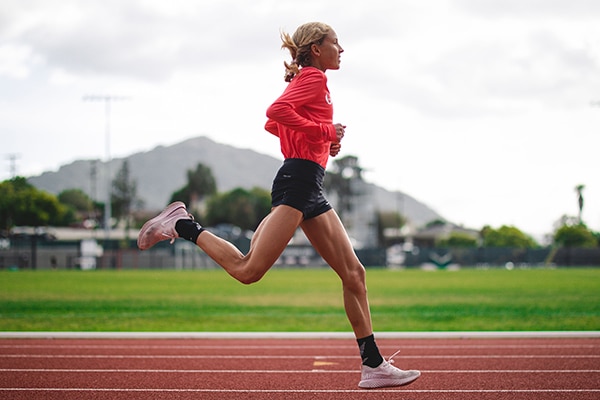How to Run Faster: Part One

Improve your running positions, make your muscles more robust, and be the fastest runner in your group. Kelly Starrett shares how to run faster with these warm up/prep strategies and end range isometric stretches. Let’s jump into some of his pre training strategies for runners.
Step 1: Warm Up & Prep
What’s one of the most effective ways to warm up and prep your body for a run? Believe it or not, it’s jumping rope. Adding in jump rope exercises before a run can help restore proper positions and mechanics, return springiness back to your body, and challenge positions that sometimes get a little bit weak or soft.
Jump Rope Routine

Position 1: For the first position, keep your toes together, butt squeezed, and body lengthened during the jumps. Don’t worry about trying to go fast or do any tricks, focus on getting a full push through plantar flexion of the foot and staying tall. This will help teach your body to absorb and have access to the whole foot. Complete 200 jumps in this position.
Position 2: The next set involves some single foot work. This will strengthen the small intrinsic muscles of the feet, help work on single leg control, and prepare your body for running loads that can be 2-4 times body weight. Keep the same general position as the first exercise, but use only one leg to jump while the other leg is extended in front of your body. Complete 100 jumps on each foot.
Position 3: It’s time to take your legs into a split stance running position. Put one foot slightly in front of your body and the other behind and complete 50 jumps. Switch which leg is in front and back, and then complete 50 more jumps.
Step 2: End Range Isometric Stretches
Loading the fascia and connective tissue into specific positions is a great way to prepare the body to run. All of these stretches will load the finishing running positions to improve your trailing leg shape. Keep your muscles active throughout the stretch, but really contract and squeeze as hard as you can during the 4 second hold.

Stretch 1: Find an elevated surface such as a curb or stacked barbells. Put your foot up to get a bite on the ledge and then step across with your other foot to load the tissues. Squeeze your glutes and take a big breath in for 4 seconds, hold for 4 seconds, and then slowly exhale and relax for 8 seconds. Do 2-3 rotations of this 4-4-8 pattern.
Stretch 2: This stretch can be done on a couch or any place where you have a floor meeting a wall. Load your back knee into the corner up against the wall of the couch. Bring your other leg up into a high kneel position. While squeeze your glutes, inhale for 4 seconds, hold for 4 seconds, and exhale for 8 seconds.
Stretch 3: Stand in front of a couch or chair and swing your leg straight back so it can rest on the fixture. Jump out with your leg that’s on the ground to create some distance. Lower yourself down while keeping your glutes engaged. Do a 4 second inhale, 4 second squeeze, and 8 second exhale and relax.
Incorporating these stretches can help create new neuromuscular end range shapes and promote better extensibility in the hip and leg. Check back for How to Run Faster: Part Two which will get into post running strategies with tissue restoration skills and drills.
You may also be interested in:
The Unexpected Cause of Many Common Running Issues & Injuries